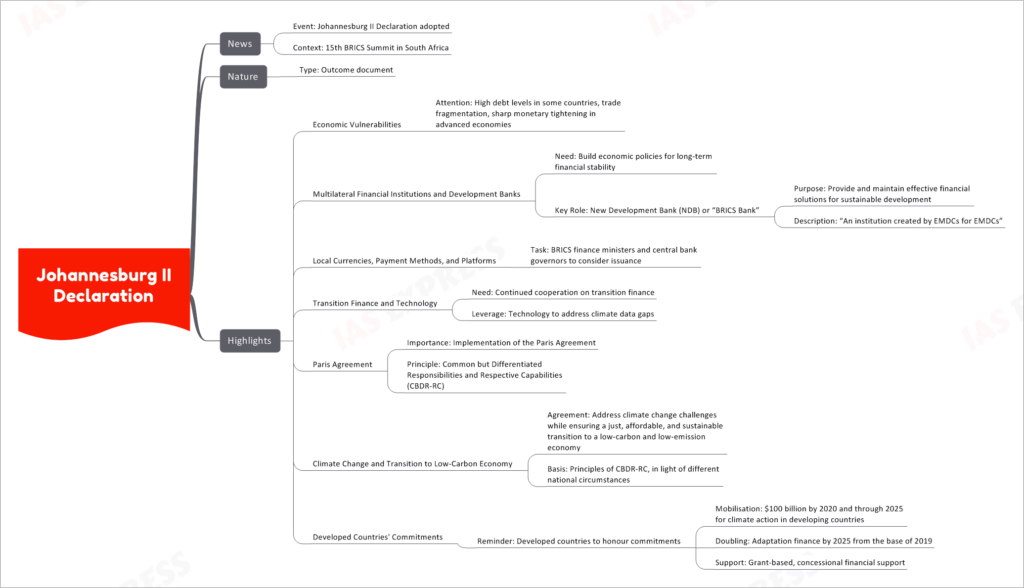Johannesburg II Declaration

The Johannesburg II Declaration has been adopted as a significant outcome document, marking the culmination of the 15th BRICS Summit held in South Africa. This declaration is a testament to the commitment of BRICS nations to collaborative efforts addressing key economic and environmental challenges.
This topic of “Johannesburg II Declaration” is important from the perspective of the UPSC IAS Examination, which falls under General Studies Portion.
Nature and Context
The Johannesburg II Declaration holds the essence of an outcome document, symbolizing the consensus achieved among BRICS nations during their summit in South Africa.
Key Highlights
Addressing Economic Vulnerabilities
- Focus Areas: The declaration draws attention to economic vulnerabilities stemming from high debt levels in certain countries, trade fragmentation, and sharp monetary tightening in advanced economies.
Enhancing Multilateral Financial Institutions
- Long-Term Stability: The document underscores the need to build economic policies that ensure long-term financial stability.
- Role of New Development Bank (NDB): The New Development Bank, also known as the “BRICS Bank,” plays a key role in providing and maintaining effective financial solutions for sustainable development.
- Purpose: The NDB serves as an institution created by Emerging Market and Developing Countries (EMDCs) to support their development needs.
Exploring Local Currencies and Payment Methods
- Task Ahead: BRICS finance ministers and central bank governors are entrusted with considering the issuance of local currencies, payment methods, and platforms to bolster economic cooperation.
Cooperative Transition Finance and Technology
- Continued Cooperation: The declaration emphasizes the importance of ongoing collaboration on transition finance.
- Leveraging Technology: The use of technology is highlighted as a means to address gaps in climate data and facilitate informed decision-making.
Upholding the Paris Agreement
- Importance: The declaration underscores the significance of implementing the Paris Agreement to combat climate change.
- Principle of CBDR-RC: Common but Differentiated Responsibilities and Respective Capabilities (CBDR-RC) remains a guiding principle for collective climate action.
Climate Change and the Path to a Low-Carbon Economy
- Collective Agreement: The declaration reflects the commitment to address climate change challenges while ensuring an equitable, affordable, and sustainable transition to a low-carbon and low-emission economy.
- Principled Approach: The principles of CBDR-RC serve as a foundation, accommodating different national circumstances.
Holding Developed Countries Accountable
- Reminder: The declaration urges developed countries to fulfill their commitments.
- Mobilization: Mobilize $100 billion by 2020 and extend it through 2025 for climate action in developing countries.
- Doubling Adaptation Finance: Commit to doubling adaptation finance by 2025 from the base of 2019.
- Support Mechanism: Developed countries are encouraged to provide grant-based, concessional financial support.

